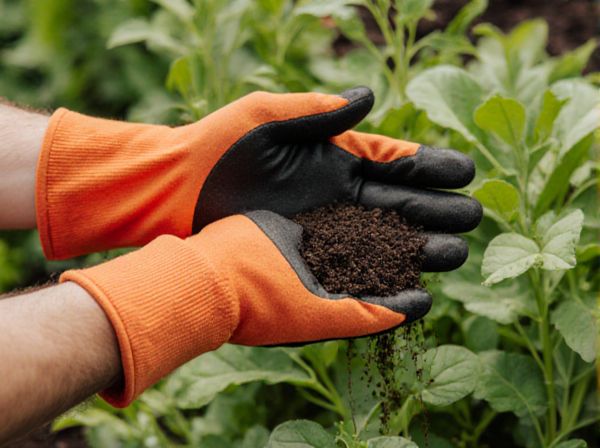
Granular fertilizer vs Liquid fertilizer Illustration
Granular fertilizer offers slow-release nutrients that improve soil structure and provide long-lasting feeding, making it ideal for outdoor crops and lawns. Liquid fertilizer delivers nutrients quickly and is easily absorbed by plants, perfect for foliar feeding and rapid nutrient correction. Choosing between granular and liquid fertilizer depends on crop type, desired nutrient release speed, and application method efficiency.
Table of Comparison
| Feature | Granular Fertilizer | Liquid Fertilizer |
|---|---|---|
| Form | Solid granules | Water-soluble solution |
| Application | Broadcast or banded on soil | Foliar spray or soil drench |
| Release Rate | Slow to moderate release | Immediate nutrient availability |
| Nutrient Precision | Less precise, bulk application | High precision dosing |
| Cost | Generally lower per unit | Higher due to formulation |
| Storage | Stable, long shelf life | Requires special containers |
| Suitability | Best for broad-acre crops | Ideal for greenhouse and high-value crops |
| Environmental Impact | Potential runoff if over-applied | Reduced runoff, but risk of leaf burn |
Introduction to Granular and Liquid Fertilizers
Granular fertilizers are composed of solid particles that release nutrients gradually into the soil, providing long-lasting nourishment for crops. Liquid fertilizers are nutrient solutions that are quickly absorbed by plants, offering immediate nutrient availability and precise application. Both types serve distinct roles in crop management, optimizing nutrient delivery based on plant needs and growth stages.
Key Differences: Granular vs Liquid Fertilizers
Granular fertilizers release nutrients slowly and are easy to apply to large areas, providing long-lasting feeding for crops. Liquid fertilizers offer rapid nutrient absorption and precise application, making them ideal for correcting deficiencies and foliar feeding. Understanding these key differences helps optimize fertilizer selection based on crop type, growth stage, and soil conditions.
Nutrient Availability and Absorption Rates
Granular fertilizers release nutrients gradually, promoting steady nutrient availability and sustained absorption rates in plants over time. Liquid fertilizers provide nutrients in a readily available form, enabling rapid absorption and immediate nutrient uptake. Differences in nutrient release mechanisms impact crop response, with liquid fertilizers often favored for quick correction of deficiencies.
Application Methods Compared
Granular fertilizer is typically applied directly to the soil surface or incorporated into the soil, allowing nutrients to release slowly and support long-term plant growth. Liquid fertilizer is often delivered through foliar sprays or fertigation systems, offering rapid nutrient absorption and precise application control. Choosing the appropriate application method depends on crop type, soil conditions, and desired nutrient delivery speed.
Suitability for Different Plants and Crops
Granular fertilizer offers controlled nutrient release, ideal for long-term feeding of row crops and cereals, allowing deep root absorption and minimizing nutrient runoff. Liquid fertilizer provides rapid nutrient availability, making it suitable for fast-growing vegetables, fruit trees, and container plants requiring immediate nourishment during critical growth phases. Crop-specific nutrient needs determine the optimal form, with granular favored for slow uptake species and liquid preferred for high-demand, nutrient-sensitive plants.
Cost Efficiency and Budget Considerations
Granular fertilizer generally offers greater cost efficiency due to lower production and transportation expenses, making it a budget-friendly option for large-scale agricultural operations. Liquid fertilizer, while often more expensive upfront, allows precise nutrient application and faster plant uptake, potentially reducing the total amount needed over time. Farmers should weigh initial investment against long-term nutrient management goals to optimize overall cost effectiveness.
Environmental Impact and Safety
Granular fertilizer releases nutrients slowly, reducing the risk of runoff and groundwater contamination, which supports soil health and minimizes environmental pollution. Liquid fertilizer offers more precise nutrient application, but improper use can lead to leaching and waterway eutrophication. Both types require careful handling to prevent exposure risks to humans and wildlife, with granular forms generally safer due to lower volatility and spill hazards.
Storage and Shelf Life
Granular fertilizers typically offer longer shelf life and easier storage due to their stable solid form, which resists microbial degradation and moisture absorption. Liquid fertilizers require airtight, opaque containers to prevent nutrient loss and microbial growth, resulting in shorter storage periods compared to granular types. Proper storage conditions such as cool, dry environments extend the usability of granular fertilizers beyond liquids, which may separate or degrade if stored improperly.
Common Mistakes to Avoid
Applying granular fertilizer too close to plant stems can cause root burn, while uneven distribution reduces effectiveness and leads to nutrient imbalances. Overapplying liquid fertilizer may result in nutrient runoff and environmental pollution, and diluting it improperly weakens nutrient delivery. Avoid using incompatible fertilizer types simultaneously to prevent chemical reactions that decrease nutrient availability.
Choosing the Right Fertilizer for Your Garden
Granular fertilizer provides a slow and steady nutrient release, making it ideal for long-term soil enrichment in home gardens. Liquid fertilizer offers rapid nutrient absorption, perfect for quick plant growth and correcting nutrient deficiencies. Selecting the right fertilizer depends on plant type, soil condition, and desired nutrient delivery speed to ensure optimal garden health.
Granular fertilizer vs Liquid fertilizer Infographic

 gardendif.com
gardendif.com